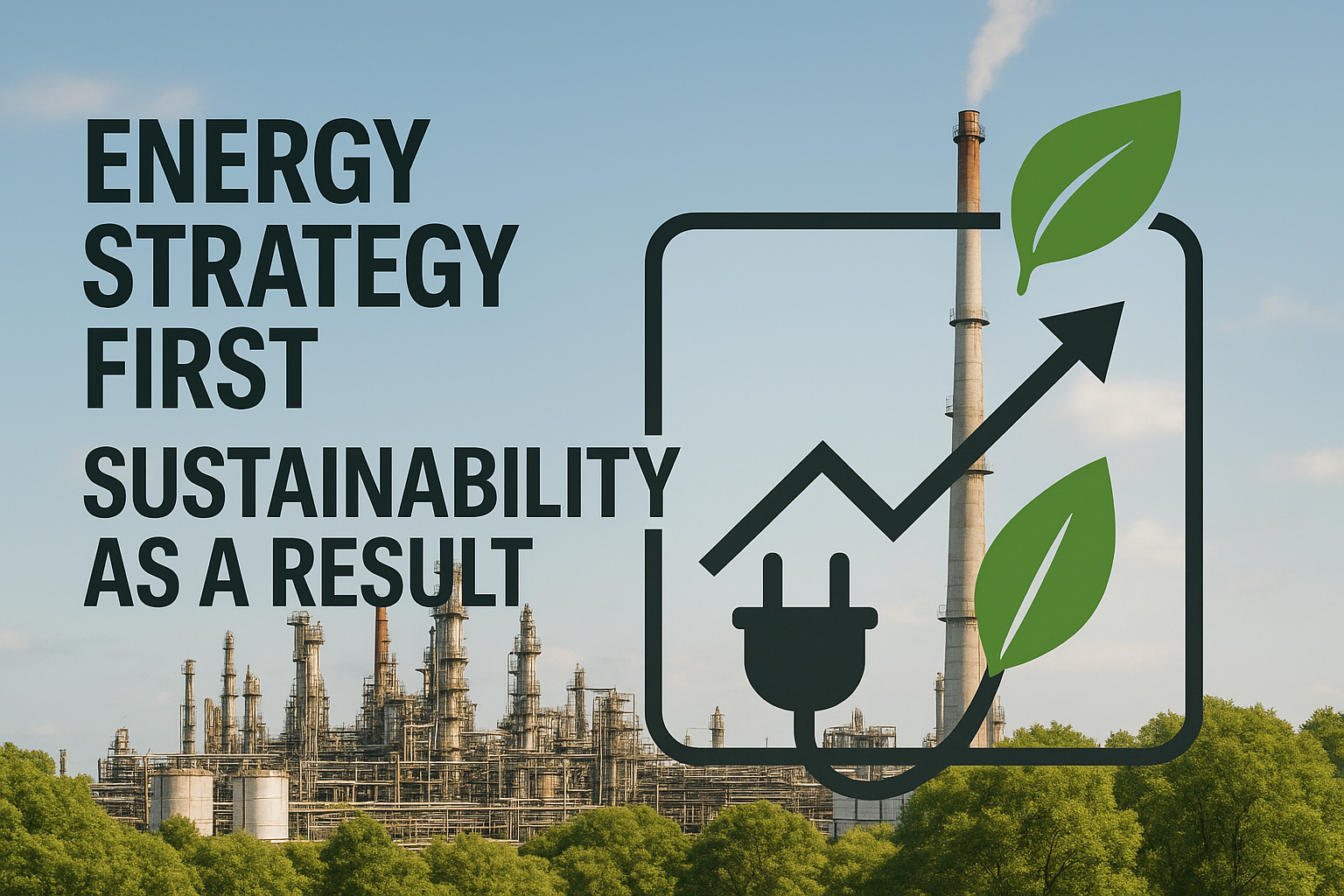Energy costs represent a significant portion of operating expenses, nearly half, in process industries, while simultaneously driving the majority of their carbon footprint, with greenhouse gas emissions stemming from fuel combustion.
This dual burden creates both financial pressure and sustainability challenges that traditional energy management approaches can no longer address effectively. Conventional systems that rely on static models, periodic reviews, and manual optimization have reached their practical limits in today’s complex operating environment.
AI transforms energy management from a reactive cost center into a strategic competitive advantage. Advanced AI optimization enables plants to balance throughput, quality, and energy consumption in ways that deliver both immediate financial returns and long-term sustainability goals.
Energy Excellence as Strategic Competitive Advantage
Forward-thinking operations leaders position energy optimization as a strategic business imperative rather than a tactical function. This approach transforms energy from a necessary expense into a competitive advantage that enhances customer relationships, investor positioning, and market differentiation.
Superior energy performance becomes a measurable differentiator in negotiations and partnerships. When energy represents a significant portion of operating expenses across process industries, even modest efficiency improvements create cost advantages that enable competitive pricing while maintaining margins. Operations executives leverage this advantage to secure long-term contracts, especially in energy-intensive industries.
Energy excellence also strengthens investor relations. ESG-focused investors evaluate companies on their ability to deliver both profitability and sustainability. Companies that reduce energy intensity while maintaining production demonstrate the discipline that institutional investors value. Executives who secure AI budget for energy optimization initiatives often see enhanced investor confidence and improved ESG ratings.
Treating energy optimization as a core business capability requires executive accountability, integrated energy metrics in production planning, and positioning efficiency as a key performance indicator. Companies making this shift discover that energy excellence becomes self-reinforcing, creating organizational capabilities that compound over time.
Why Traditional Energy Management Can’t Keep Pace
Conventional energy management systems cannot handle the complexity and speed of modern process industries. These systems face key limitations:
- Lack of real-time data access and processing capability
- Inability to manage large data volumes at high velocity
- Outdated infrastructure is unsuitable for predictive analytics
- Reliance on single-variable optimization that can’t adapt to changing conditions
- Dependence on periodic reviews that miss real-time opportunities
Traditional approaches optimize units in isolation rather than coordinating interconnected components across entire systems. Steam networks, utility systems, and fuel switching decisions involve hundreds of variables that exceed human capacity to process simultaneously. Manual optimization simply cannot balance multiple interacting units, variable energy prices, production demands, and environmental constraints in real-time.
These limitations intensify as plants incorporate renewable energy sources and face volatile energy markets. Traditional systems lack the computational power to evaluate millions of potential operating combinations while maintaining safety and production constraints, and cannot dynamically adjust to changing conditions.
Human decision-making creates additional bottlenecks in complex scenarios. While operators excel at managing individual units and immediate challenges, they struggle to identify non-obvious relationships between production parameters and energy consumption across entire plants. These cognitive limitations prevent even experienced teams from discovering the optimal operating strategies that AI optimization technology can identify.
AI Discovers Value in Energy Trade-offs You Never Knew Existed
AI optimizing technology uncovers hidden relationships between production parameters and energy consumption that humans and traditional systems cannot detect. It evaluates millions of potential combinations to identify optimal operating points that balance throughput, quality, and energy use. The technology discovers non-obvious patterns, like strategically relaxing upstream temperature controls to enable tighter downstream control while maintaining product quality.
These systems reveal counterintuitive optimization opportunities, such as how slightly reducing efficiency in one unit can dramatically improve overall plant energy performance. The AI optimization technology continuously analyzes complex interactions between variables to identify operating sequences that significantly reduce energy consumption while maintaining production targets.
Beyond simple parameter adjustments, this approach identifies strategic trade-offs that transform energy management:
- Optimal timing for energy-intensive operations based on real-time costs
- Fuel switching opportunities that operators typically miss
- Production scheduling modifications that reduce peak energy demand without impacting throughput
Through continuous learning, these systems become increasingly sophisticated over time, identifying subtle optimization opportunities as they process more operational data and enabling proactive adjustments that prevent energy waste rather than merely reacting to inefficiencies.
From Reactive Compliance to Proactive Sustainability Leadership
AI transforms sustainability from a compliance burden to a strategic advantage by enabling plants to exceed environmental targets while improving profitability. Rather than viewing energy reduction as competing with production goals, AI reveals strategies that enhance both simultaneously. AI-driven optimization delivers carbon reductions while increasing production through system-wide approaches that traditional methods cannot match.
Predictive optimization enables dynamic carbon footprint management by adjusting operations during high grid carbon intensity periods. This approach minimizes environmental impact without sacrificing throughput. AI systems shift energy-intensive processes to periods of greater renewable energy availability, reducing both costs and emissions.
Proactive sustainability creates competitive advantages by attracting ESG investment and environmentally conscious customers. This positioning becomes more valuable as carbon pricing expands and regulations tighten, giving companies margin improvements and competitive advantages.
Beyond emissions reduction, AI-powered sustainability optimizes all resources. Advanced systems reduce waste and improve raw material utilization, creating compound benefits that strengthen both environmental and operational performance.
The strategic advantage lies in future-proofing operations against evolving regulations and market demands. Companies establishing AI-driven environmental excellence today position themselves ahead of regulatory curves that will shape future competitive dynamics.
Creating Resilience Through Intelligent Energy Flexibility
AI-powered energy optimization builds operational resilience by creating adaptive strategies that protect margins during energy market volatility and supply disruptions. These intelligent systems enable plants to capitalize on favorable energy pricing in refining operations while maintaining production targets and safety requirements. AI enables load shifting and fuel switching capabilities that create operational flexibility, allowing facilities to reduce energy costs while simultaneously strengthening supply chain resilience during periods of market disruption.
Dynamic load shifting capabilities allow operations to automatically adjust energy consumption patterns based on real-time costs and availability. AI systems can postpone non-critical energy-intensive processes during peak pricing periods and accelerate them when costs are favorable, creating significant cost savings without impacting production schedules.
Fuel switching optimization provides additional flexibility by continuously evaluating multiple energy sources and automatically selecting the most cost-effective options. AI systems consider not only current pricing but also availability, carbon intensity, and operational constraints to optimize fuel decisions in real-time.
The resilience benefits extend beyond cost optimization to include supply chain protection and business continuity advantages. Plants with AI-driven energy flexibility can continue operations during supply disruptions that force less sophisticated competitors to reduce production or shut down entirely.
This operational continuity protects customer relationships and market share during challenging periods, with AI-powered systems enabling dynamic load shifting and fuel switching to adapt to disruptions that traditional systems cannot manage.
Measuring Strategic Impact Beyond Simple Payback
Comprehensive value measurement for AI-driven energy optimization can benefit from expanding beyond traditional cost savings to capture strategic benefits across multiple dimensions. Smart performance measurement systems incorporate production flexibility improvements, reduced carbon pricing exposure, enhanced equipment life from optimized operation, and decreased variability in energy consumption.
AI-driven energy excellence improves plant reliability scores by reducing unplanned downtime and minimizing equipment stress from suboptimal operating conditions. These reliability improvements reduce insurance premiums, lower maintenance costs, and strengthen supply chain partnerships by ensuring consistent delivery performance.
The measurement framework should quantify competitive positioning advantages that result from superior energy performance. This includes the ability to offer more competitive pricing in customer negotiations, reduced exposure to energy market volatility, and enhanced investor confidence from demonstrated operational excellence through improved ESG ratings.
Advanced measurement approaches incorporate predictive value metrics that forecast future benefits from continued AI learning and optimization. As AI systems accumulate more operational data and refine their optimization strategies through continual learning mechanisms, they discover increasingly sophisticated efficiency opportunities that compound over time while preserving optimized control behaviors across evolving process conditions.
How Imubit Delivers Strategic Energy Optimization Excellence
Imubit’s Closed Loop AI Optimization solution embodies strategic energy excellence by delivering autonomous optimization that balances efficiency with production goals. Through reinforcement learning (RL) that processes plant data in real-time, Imubit transforms energy management from cost control to strategic advantage.
The platform uncovers hidden optimization opportunities by analyzing complex interactions between hundreds of process variables simultaneously. This system-wide approach increases production and improves operations while reducing carbon emissions and creating competitive advantages.
Unlike traditional advanced process control (APC) solutions, Imubit’s AIO technology continuously learns from plant operations, creating optimization strategies that grow more sophisticated over time. The solution integrates with existing plant systems without disrupting operations.
For process industry leaders transforming energy from cost center to competitive advantage, Imubit provides a proven industrial AI platform that delivers immediate financial returns and long-term strategic positioning. Get a Plant Assessment to discover your optimization potential.




